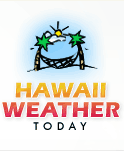Hawaiian Island weather details & Aloha paragraphs
Posted by GlennJuly 2-3 2008
Air Temperatures – The following maximum temperatures were recorded across the state of Hawaii Wednesday:
Lihue, Kauai – 84
Honolulu, Oahu – 90
Kaneohe, Oahu – 84
Kahului, Maui – 87
Hilo, Hawaii – 85
Kailua-kona – 84
Air Temperatures ranged between these warmest and coolest spots near sea level at 4 p.m. Wednesday afternoon:
Kapalua, Maui – 88F
Hilo, Hawaii – 82
Precipitation Totals – The following numbers represent the largest precipitation totals (inches) during the last 24 hours on each of the major islands, as of Wednesday afternoon:
0.25 Waialaele, Kauai
0.12 Kahuku, Oahu
0.02 Molokai
0.04 Lanai
0.04 Kahoolawe
0.55 Hana airport, Maui
0.25 Honokaa, Big Island
Weather Chart – Here’s the latest (automatically updated) weather map showing a 1024 millibar high pressure system located far to the north-northwest of the islands. This high pressure cell, along with its associated ridges, will keep our trade winds blowing. Look for light to moderately strong winds, with those windier areas finding stronger gusts through Friday. Here’s a link to the NOAA weather school.
Satellite and Radar Images: To view the cloud conditions we have here in Hawaii, please use the following satellite links, starting off with the Infrared Satellite Image of the islands to see all the clouds around the state during the day and night. This next image is one that gives close images of the islands only during the daytime hours, and is referred to as a Close-up visible image. This next image shows a larger view of the Pacific…giving perspective to the wider ranging cloud patterns in the Pacific Ocean. To help you keep track of where any showers may be around the islands, here’s the latest animated radar image.
Hawaii’s Mountains – Here’s a link to the live webcam on the summit of near 14,000 foot Mauna Kea on the Big Island of Hawaii. The tallest peak on the island of Maui is the Haleakala Crater, which is near 10,000 feet in elevation. These two webcams are available during the daylight hours here in the islands…and when there’s a big moon rising just after sunset for an hour or two! Plus, during the nights and early mornings you will be able to see stars, and the sunrise too…depending upon weather conditions.
Aloha Paragraphs

A nice way to end the day
Photo Credit: Flickr.com
After a period of lighter than normal winds here in Hawaii, we’ve seen returning trade winds Wednesday. The latest weather map shows a 1027 millibar high pressure system located to the northwest of Hawaii. The leading edge of these returning winds, will arrive from the northwest Wednesday evening. Trade winds coming in from this direction often have a slightly cooler feel to them, than when they blow in from the east…although with a minimal influence during the summer season. These winds will continue through the rest of this week, right on into next week.
The atmosphere has become dry and stable behind the recent out of season cold front. This satellite image shows that the leftover clouds, from the frontal boundary, have mostly evaporated, leaving the state mostly sunny late Wednesday afternoon. Computer forecast models suggest that we’ll see just a few off and on showers falling on those windward sides. As we move into the upcoming weekend, we may see some increase in showers again along the windward sides. The leeward areas will remain generally dry, as would be expected this time of year.
The eastern Pacific remains active with tropical storm Boris, and tropical storm Douglas churning the waters. Here’s a storm tracking map, showing the two systems in relation to the
~~~ I’m starting to run out of adjectives to describe the abnormal weather that we’ve seen happening here in the Hawaiian Islands! Yesterday’s very unusual cold front, brought lots of clouds, and many showers to our islands. This was a boon though, as we so needed the rainfall! We saw less than the normal amount of showers during our spring season, which has us going into our typically dry summer months on the verge of a drought…perhaps beyond verge! At any rate, it was wonderful to see such a rare frontal cloud band dip so far south into the tropics.
~~~ The computer forecast models remain on our side, so to speak, as they’re suggesting that we may find more showers arriving this weekend. These showers would be taking aim on the windward sides. The source of these showers would be the close proximity of low pressure systems aloft, along with plenty of available moisture near the surface…to feed the showers. At this point we will take whatever showers we can get, and if see these wet trade winds manifest as pointed out by the models, we will be lucky!
~~~ It’s early Wednesday evening here in Kihei, Maui, as I begin writing this last paragaph of this morning’s narrative. Skies were still quite cloudy early this morning, what with the remnant moisture from yesterday totally unusual cold front. During the day however, those clouds have pretty much completely cleared away, leaving a sunny day in their place. I expect dry and sunny weather to remain in place through Friday. As we move into the weekend, we may see some increase in windward showers, let’s fine tune that prospect over the next couple of days. We have the upcoming 4th of July holiday on Friday, so we want to definitely have good weather for everyone who will be outdoors having fun! I’ll be back very early Thursday morning with your next new weather narrative, I hope you have a great Wednesday night until then! Aloha for now…Glenn.
By the way, as many of you know, I have a ping pong table on my deck up in Kula, just outside my weather tower. If you were wondering what our game playing looks like, here’s a good example how a typical game would look…yeah right Glenn!
Interesting:
The Hong Kong Observatory has declared June 2008 its wettest month ever on record, with records dating back to 1884. Up to midday on Monday June 30th, the total rainfall recorded at the Hong Kong Observatory was 1,346.1mm (53 inches) breaking the previous record set in May 1889. The previous rainfall record was 1,241.1mm (49 inches). The heavy rain is being attributed to active southwesterlies over the south
This set a new record at the Hong Kong Observatory for the highest rainfall ever recorded in an hourly period. The rain triggered floods and landslides prompting the highest level of weather alert. Rainfall during the second half of June is being attributed to Typhoon Fengshen. Fengshen which first lashed the
Interesting2:
Hundreds of soldiers cleaned it up by hand in a seaside park Wednesday. About 10,000 ordinary citizens were doing the same along the shore, while more than 1,200 fishing and other boats hauled it in by net, the workers smiling and flashing the two-fingered victory sign to journalists. "We all need to pitch in," said Gao Shaofan, a massage parlor employee who was stuffing the algae into plastic sacks with her co-workers. "This is the worst it’s ever been that we know." Chinese officials promised at a news conference Wednesday that the Olympics competition area, all 19 square miles of it, will be clear of the algae before races begin Aug. 9th.
Interesting3: Iowans will eventually see more severe flooding every few years because of new flood risks, including rain patterns altered by climate change, the National Wildlife Federation said Tuesday. "Big storms we expected to see every 20 years should be expected every four to six years by end of century," said Amanda Staudt, a climate scientist for the federation who led a news teleconference Tuesday on the issue. The group said the U.S. Army Corps of Engineers is giving Iowans a false sense of security about the potential for future flooding, even as they have struggled with this year’s record damage. The corps’ latest flood-frequency projections, completed in 2004, did not anticipate more intense rainfall predicted because of climate change and underestimated how high water would rise during floods, the group said.
A spokesman for the Army Corps said that the group’s assertions were not based on solid research and that the flood projections the corps uses are sound. During Tuesday’s teleconference, Southern Illinois University geologist Nicholas Pinter said that
Interesting4: During the European heat wave of 2003 that killed tens of thousands, the temperature in parts of
Sterl, who is with the Royal Netherlands Meteorological Institute, projects temperatures for rare heat waves around the world in a study soon to be published in the journal Geophysical Research Letters. His numbers are blistering because of the drying-out effect of a warming world. Most global warming research focuses on average daily temperatures instead of these extremes, which cause greater damage. His study projects a peak of 117 for












 Email Glenn James:
Email Glenn James: